After thinking about Ellen Degeneres’ viral anti-meat tweet a couple of weeks ago, Glenn thought maybe it was time to shoot a letter to her. Don’t know if she’ll ever get to it, but we just thought we’d better cc it to you all.
Dear Ellen
I’m a cattle rancher in the broad expanse of the American West. I wear a cowboy hat, ride a horse and have the pointy boots with toe stitching on them. And on “being neat and eating less meat,” I agree with you. We, as a culture and as a species, need to eat far less of the meat that is produced today.
I ranch full time in the central mountains of Idaho. For 27 years my wife, Caryl, our seven (yes, seven!) daughters, and I have worked together to raise Black Angus cattle on Alderspring Ranch. Today, we run our nearly 500 cattle on 47,000 acres of wild Idaho. We raise beef.
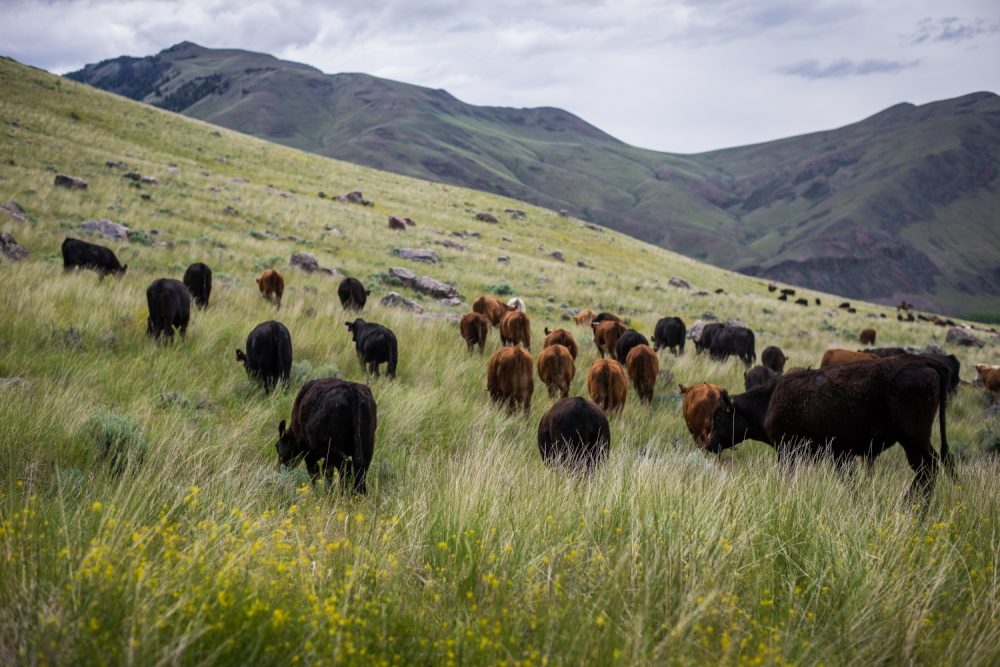
But we raise a different kind of beef than 99.5 percent of the beef eaten in America today. We raise our beef in the way all animal protein used to be raised, or to put it more correctly: how it used to raise itself.
Our meat production model in America has lost its way over the past 70 years. Most of our human ancestors consumed diets based on wild plants and animals. And those wild beasts grazed and walked upon living soils, dense with life, and rich with carbon. The paleo record shows it: our collective genome is founded on animal protein and native vegetation. Unfortunately, that protein mainstay is not of the kind of protein produced in our modern age. The protein of bygone days had nothing to do with concrete and steel feedlots, tractors, petroleum, chemicals, corn or the naked soil that is exposed to erosion, year after year.
Think about it. It takes vast amounts amount of carbon-emitting petroleum to raise corn and other row-crop feedstuffs for cows, pigs and chickens in the Heartland. Farm equipment burns fuel, and lots of it. Fertilizers, herbicides and pesticides are founded on petroleum. When oil goes up in price, so do agrichemicals. They are joined at the hip.
The monoculture of corn agriculture is insatiably thirsty for fuel.
In addition, the monoculture of corn is insatiably thirsty for fertilizer. Recently a Cornell University study found that methane (a greenhouse gas thought to be even more detrimental than CO2) emissions from ammonia fertilizer plants were 100 times higher than the fertilizer industry’s self-reported estimate. They also were 3X higher than the Environmental Protection Agency (EPA) estimate for all industrial processes in the United States. Three times!
These agricultural related emissions are not offset by carbon placed in the soil. Annual crops like corn have roots that are ephemeral; much of the litter oxidizes and leaves very little for soil life after the crop is harvested. Organic material, such as roots, insects, bacteria and fungi are few or nonexistent due to chemical inputs to the soil profile and the lack of deeply rooted perennials. Organic material, or carbon, in midwestern soils is less than 10% of what it was pre-settlement, when it was tallgrass prairie as far as the eye could see.
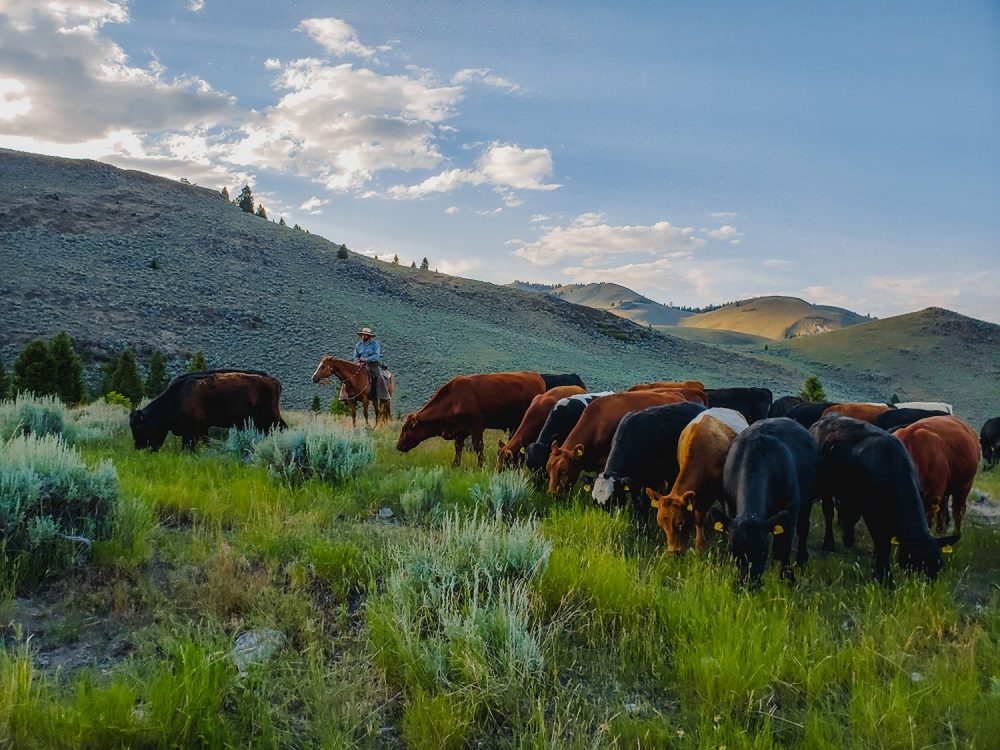
What I was hoping was that you would discuss the thought that all meat is not equal. The fact here is not that we are simply eating meat in excess, but more specifically that we are almost categorically eating meat that has been wrongly raised.
And what about our health? Confinement raised animal proteins are very low in phytochemical composition. Phytochemicals abound in the wild plants growing in native soils that our genome has thrived on for millennia. The row crop industrial paradigm simply has no access to the phytochemical richness of native plant diversity on wild soils. These are the chemicals that counteract cancer, reduce inflammation and accompany healthy fats crucial for brain function.
For humankind to survive, we must significantly reduce consumption of the industrially sourced animal proteins that are manufactured today (I intentionally left out the words raised or grown). These problem proteins are killing us with chronic disease. Furthermore, with the net CO2 loss to the biosphere, they are detrimentally altering the planet as well.
And then, there are the animals themselves. I believe confinement in concrete and steel surrounding mud, dirt and dust to be inhumane. Cows have legs and are made to ambulate. They have long tongues with which to harvest grass. They have gastrointestinal systems uniquely suited to ferment otherwise indigestible grass. And they have personalities. Thoughts. Memories.
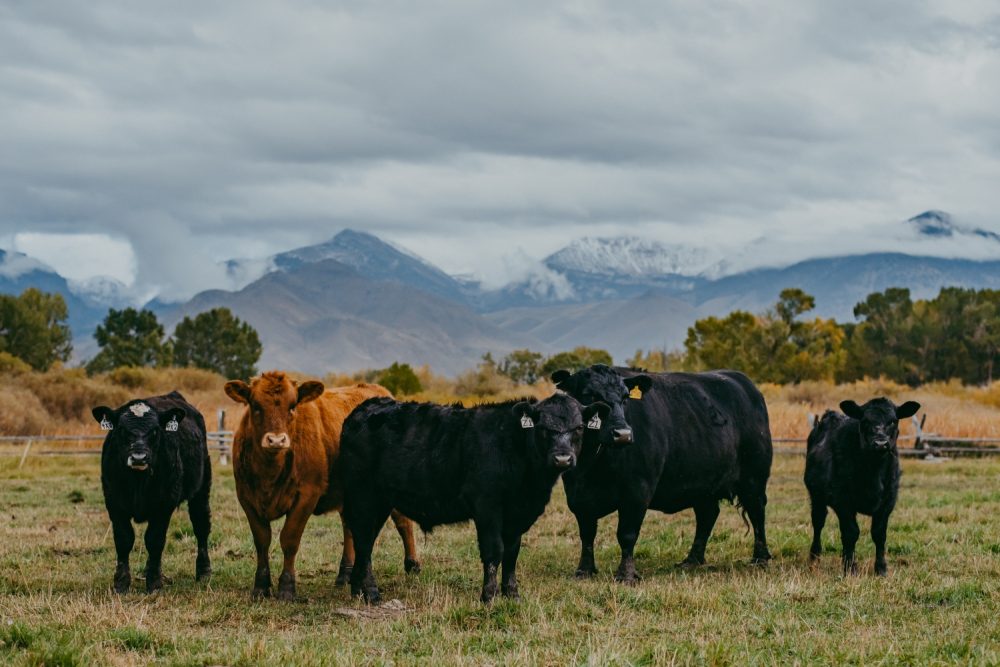
Animal and human, and the planet they both walk on are all in trouble.
Come with me, Ellen, for a moment, on a sort of virtual horseback ride with us and our beef cattle on the open ranges of Idaho. To some degree, it is a ride back in time, where we recreate pastoralism, the nomadic life in which humans used to live with their grazing animals. That is not to say we turn our back on technology; we use electric fence, GPS systems and satellite imagery in our work. Here in the high Idaho ranges, you can experience a different agricultural model, and I believe it is one of hope. It’s a model that is founded on one of the most ancient relationships humankind had with animals—that of husbandry. It’s a paradigm where animals are grazed in a way that mimics that which nature has long been expert at: growing wild ungulates on native grasslands.
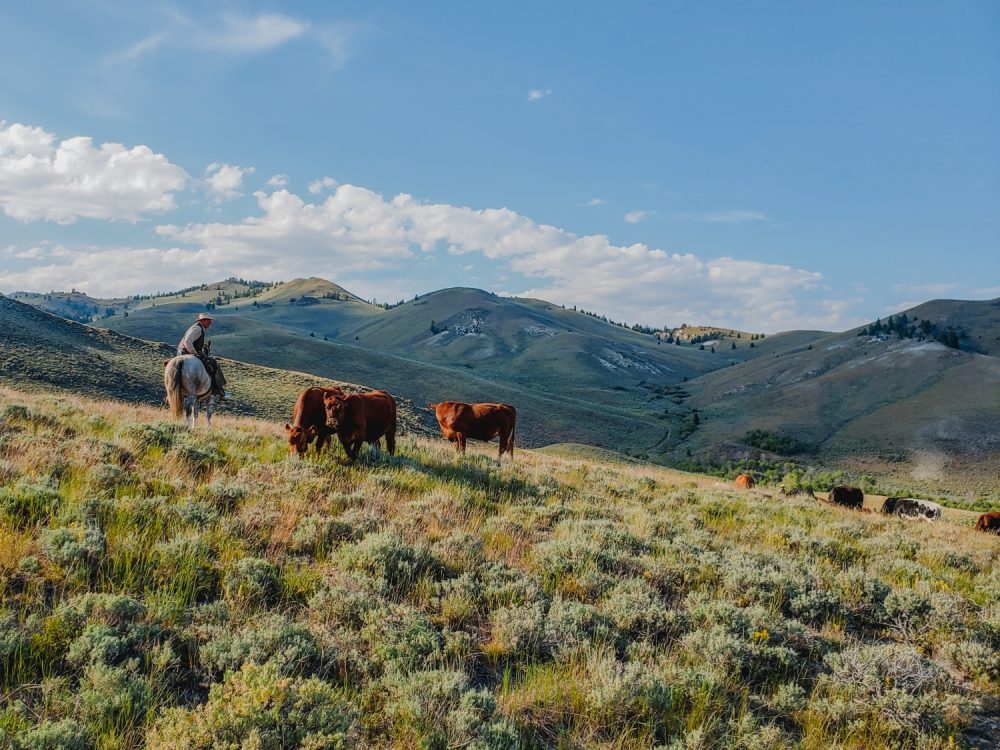
And now, for that horseback ride:
In the summer, we live in the wilderness. Our workplace, our office, and even our bedroom if you will, is sprawled out over seventy square miles of rugged mountain and canyon breaks in a remote region of Idaho’s snow-streaked Rocky Mountains. There are usually three of us on herding duty at a time. Most days, one or two of my daughters are up there on crew. Our nomadic progression of nine summer camps is primitive, and we leave no trace that we’d been there; we make our bedroll on the earth, lying on grass or pine needles. Our only shelters are a canvas tarp and a few small tents spread out under the whispering crowns of native Douglas-fir trees. Those evergreens serve as adequate protection from the extremes of mountain weather, which can treat us to a relentless spectrum of ninety-degree high desert heat one day and freezing rain often accompanied by spitting snow the very next day.
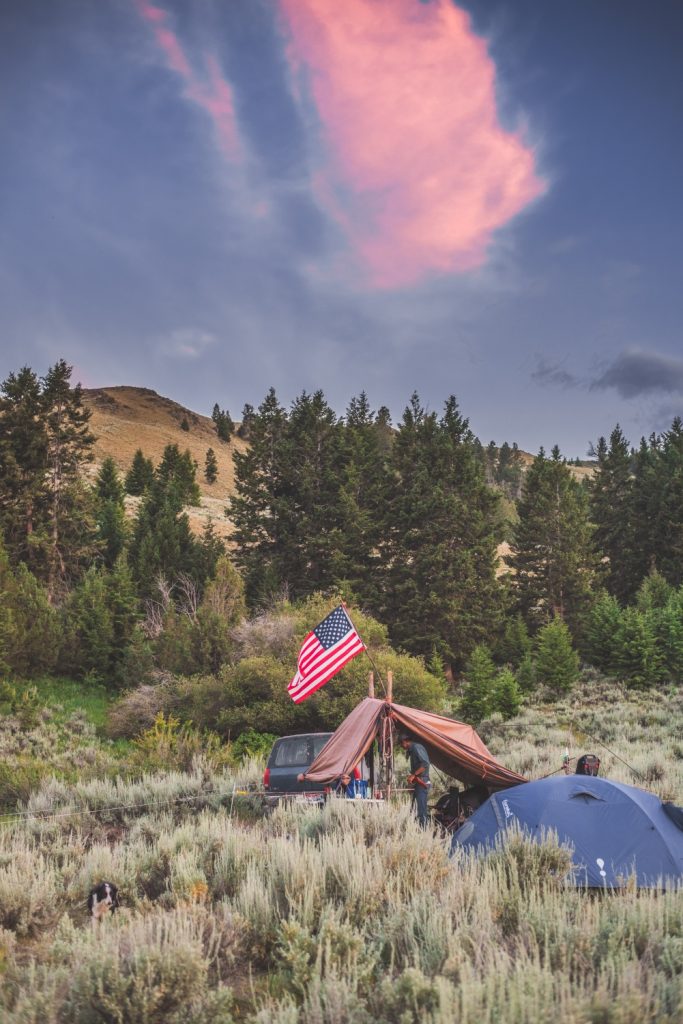
It is rare that we see another human over the entire summer. There is no cell service. Our wild companions on these pristine ranges are wolves, bears and mountain lions that dine on the plentiful elk, bighorn sheep and deer that graze here.
With us are 400 or so of our charges: a large herd of young beef cattle, an average of 7 horses, and 2 border collies named Clyde and Mindy. They are all with us 24/7. After saddling up early each morning, we and the dogs and horses fulfill our daily quest: find for the beeves the most nutrient dense, diverse grasses and wild forbs for them to eat. Each day, we intentionally herd them on horseback as a group in the process we call inherding (short for intensive herding), a practice that marries “ecological doctoring,” as Dr. Fred Provenza calls it, and animal husbandry—meal planning at an intense level to meet the needs of both animal nutrition and rangeland health.
With a practiced hand at complete control of all beef animals, we bed down the cattle with us each night for safety from wolves, and during the day, while herding them to fresh pasture, we condition them to avoid grazing the 55 miles of perennial trout bearing creeks that wind through the range. I’m cognizant of the great privilege of being a steward of such a place. It is a beautiful, sometimes austere and largely pristine summer range we call Hat Creek, and part of our mission is to literally leave no impact on sensitive habitats.
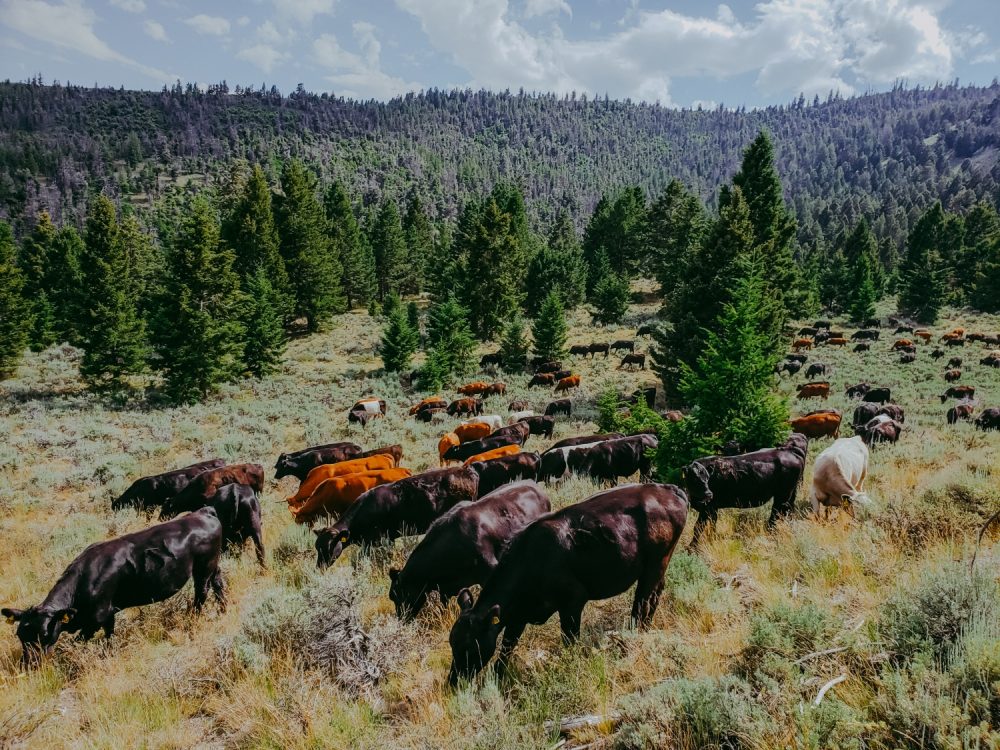
And in that we are succeeding. In the past three years, data from rangeland monitoring demonstrated that less than 1% of all wetland and stream miles had any sort of bovine impact on them. Before our practice of inherding, we didn’t live with and herd our cattle intensively. Instead, we allowed them to roam quite freely across the landscape, confined only by barbed wire fence, as nearly every other rancher in the Rockies does. As a result of those conventional management practices before we began the inherding experiment, sixty-five percent of our stream miles had cattle impacts to them. Some of these were adverse impacts to birds and fish that depend on these wet areas for nesting and spawning.
But now, the tables have turned. Creeks are in full regeneration mode; even the beleaguered Sage Grouse, the “Canary in the Coal Mine” of the Sagebrush Ocean’s deteriorating habitat, appears to be on the rebound. Woody species such as aspen and alder are recolonizing in vigorous resurgence, providing feedstuffs, cover and temperature relief for birds and numerous terrestrial species, as was the case when prehistoric herds of bison and bighorn sheep roamed across the landscape (they were never wetland area grazers as domestic cattle can be).
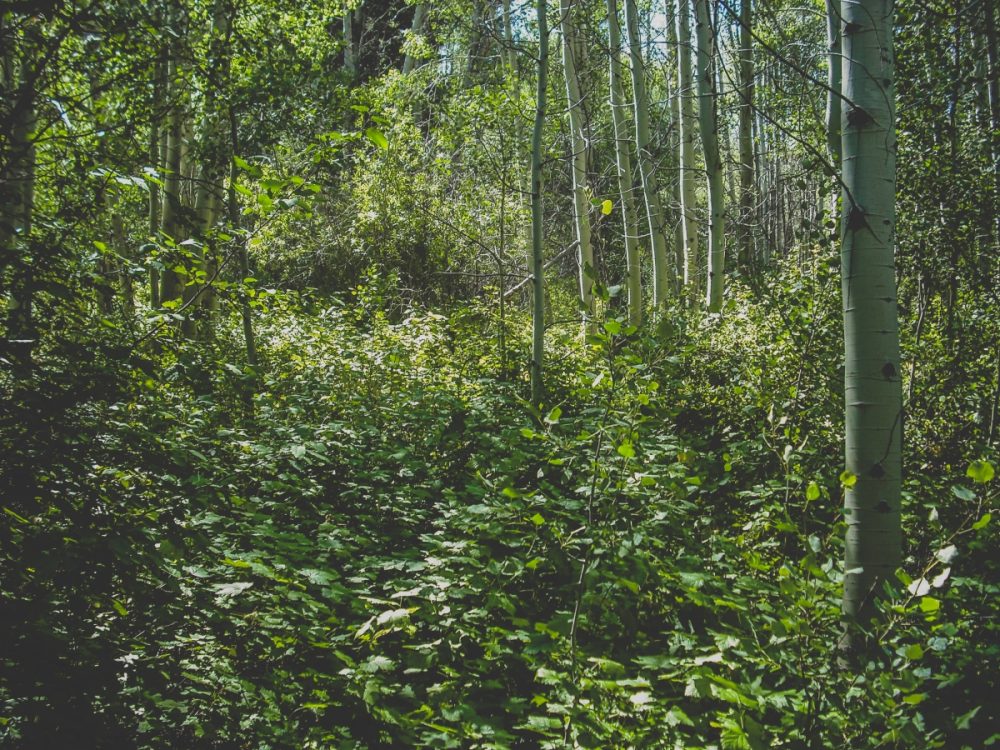
Amazingly, beavers are recolonizing our once degraded and woody species depauperate streams (we don’t even know where they came from—they just showed up as the wetlands became healthy again). Nature is regenerating with a fury we never anticipated before starting this journey of conservation grazing. It is biodiversity run amok.
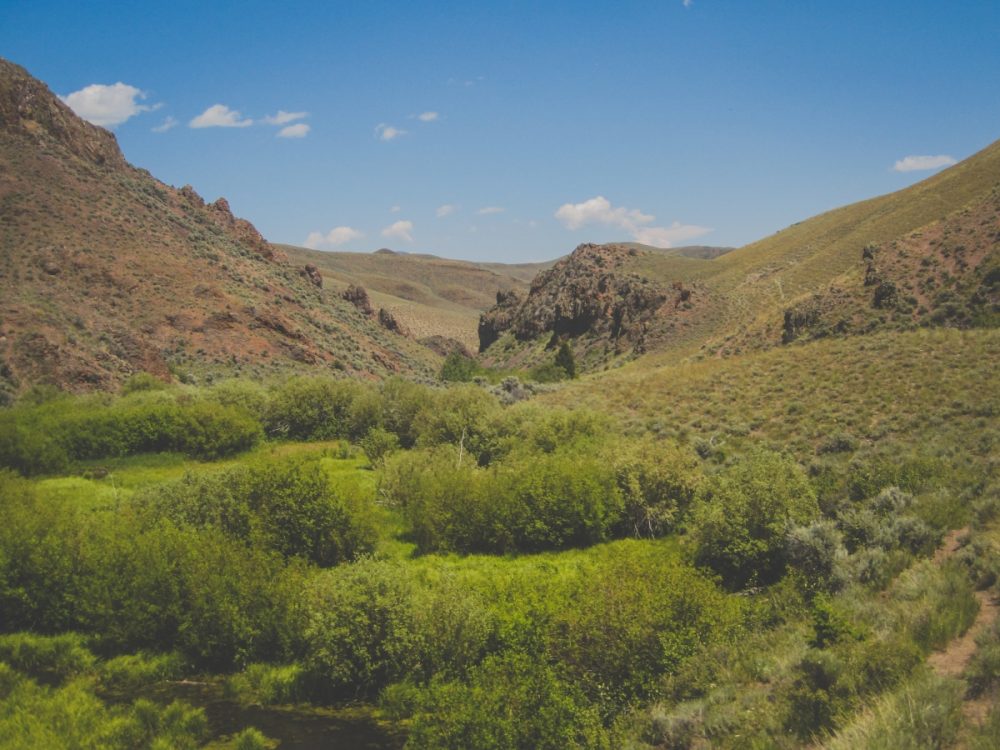
Carbon sequestration on a grand scale naturally follows with the onset of vegetative regeneration and the rising water table as beavers build their dams where they naturally make their homes. Rough estimates indicate with our inherding experiment over the past 5 years, Hat Creek has sequestered over 8000 tons of carbon from the atmosphere, transformed to renewed vegetative expression.
There are no tractors where we herd our cattle. There is no noise except the wind rushing through the trees and the haunting call of nighthawks. There is no open soil, exposed to the air and to erosion. There is no corn, no genetically modified monocultures. There is only us, on horseback, guiding our beeves to diverse mountain grass pastures. In actuality, we are harvesting sunlight as our beef cattle graze this vegetation and we are converting it to a beautiful, life giving food for our loyal customers, who purchase our beef online.
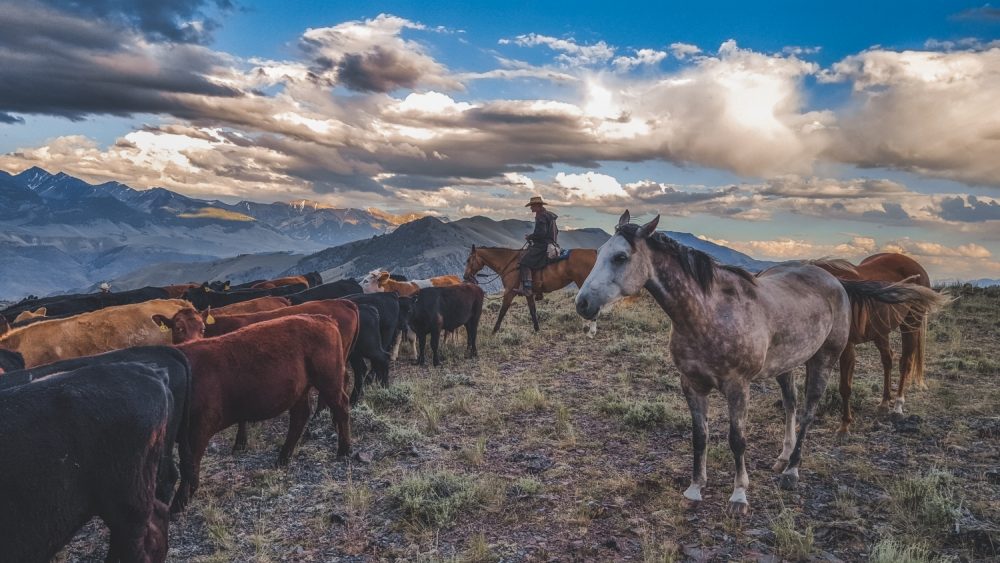
Inherding as an idea commenced 5 years ago when I read The Art and Science of Shepherding, an under-the-radar book presented by Michel Meuret and Fred Provenza. In the book, I learned of a new paradigm for managing grazing livestock in the Alps and Pyrenees of France. There, highly trained herders are very intentional about how they graze their animals, selecting forages specific to the needs of individual animals. French alpine shepherds are strategizing how to graze in a way that heals, rather than harms the environment they live and work in. Their grazing was described as proactive, rather than reactive. What if we adopted those ideas, I thought, and applied them to the Rocky Mountain West? What if, instead of continually herding our recalcitrant cows out of creeks and sensitive areas (reactive), we intentionally, pressure and release low stress animal handling techniques, trained them to avoid those areas?
For us, on Alderspring Ranch, the idea had even further reaching significance: what if we intentionally sought nutrition density in the diverse plant species the cattle grazed each day? It had obvious consequences for increasing the animals’ weight gain and growth, but we also knew that it could increase their physical wellness. And so, over 5 years of inherding, we are seeing these ideas become reality. Certainly, we learn more each summer grazing season, but the positive outcomes were recognizable in the first year of experimentation. The animals fare differently; in five years of practicing this proactive nutrition selection of wild plants through herding and targeted grazing, our animals exhibit extraordinary wellness. We’ve had to administer veterinary attention to less than one tenth of one percent of all the animals we’ve had up there; typical bovine diseases of foot rot and pinkeye have become non-existent in our herd.
For any beef producer, those changes are significant. Like many things in life, entry through new doorways presents even more opportunity. You see, the beeves we graze on these wild landscapes of Hat Creek have a destiny; their ultimate destination is arriving on someone’s table as our organic grass-fed beef. Our internet business of presenting such nutrient dense foods for human consumption is brisk. It is no wonder, as the mineral and phytochemical richness of the beef we raise finds its basis on 550 species of graze-able wild plants found endemic to the Western range landscape. Our patrons believe the flavor and wellness in that Alderspring Ranch-raised ribeye is unparalleled.
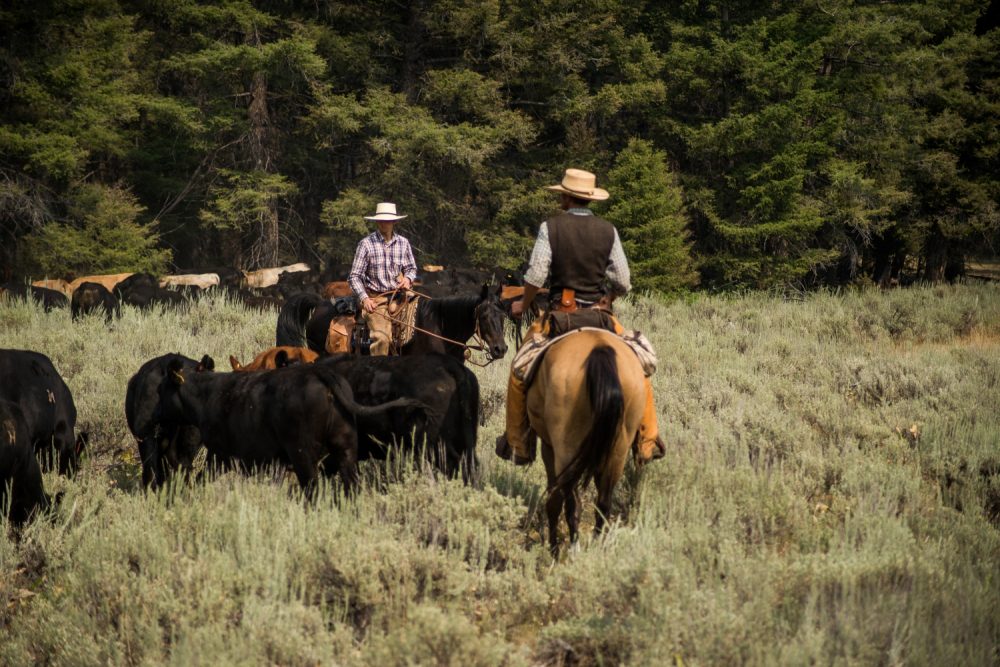
That species diversity and phytochemical richness in our beef, typical for pristine landscapes found in ancient prairies to mountain peaks, is unfortunately lacking in today’s meat available for human consumption. Over 95% of all beef consumed in the US originates from feedlots with forages usually comprised of less than 5 plant species, the lion’s share of which is pure energy concentrate feeds like corn. This nutrient simplicity results in many feedlot-bound bovines dying from acidosis or other confinement/concentrate ration ills, necessitating the existence of “hospital pens” and “pen riders,” the required employees that continuously monitor bovine feed yard occupants for sickness.
Corn and other concentrate rations are important for concentrated animal feeding operations (CAFOs), whether it be hog facilities, beef feedlots or the new mega-dairies that are silently colonizing the Midwest. But producing these feedstuffs requires abundant acreages, excessive chemical use, and a juggernaut of petroleum consumption and the concurrent carbon emissions to pull it all off. Soils, unfortunately, are largely compromised to grow these crops, even to the point of non-existent perennial soil biota.
In 1937, Franklin D. Roosevelt observed that a “nation that destroys its soils destroys itself.” Unfortunately, soil conservation efforts since the days of FDR’s Dust Bowl era have focused on the stabilization of dirt, the nonliving, chemical and structural component of soil. Now we are just beginning to realize that soil biota and the concurrent existence of dense organic matter is the true indicator of soil health. But most of our agricultural soils are dead, with limited biota and soil organic matter hovering around 1%. So, have we destroyed ourselves as President Roosevelt predicted? Is it too late?
So, perhaps, Ellen, you wonder: why am I telling you this story, about how my daughters and I have made a home on the range? I would like you to think about this: what if we carried this paradigm forward to regenerate the remainder of the depleted, arid West? Concurrently, and perhaps even more significantly, what if we recovered a grassland agriculture in what was once the greatest grassland of the world: our North American prairies? Furthermore, what if we could carry this regenerative vision across whole of this beautiful planet, restoring soils have perished through the monocultured and chemical agriculture that we have so championed?
Instead of monocultures of corn, cereal grains and soybeans, we as agriculturalists could also become grassland stewards and protein husbandry purveyors, as occurred globally until the advent of row crop “efficiencies” in post-industrial age America. Grasslands are widely known as one of the most efficient carbon-sequestering agricultural biomes on the planet; the vexing issues of climate change are in no better way solved than by restoring these grasslands to their natural potential. Animal protein grazed and raised on such grass-based pasturage curates and provides for us nutrition with a phytochemical richness that we humans fail to emulate in our mechanistic practices. We currently grow poor vegetables and grains on dead soils. The grass fed ruminant, meanwhile, brings an elegance of nutrient acquisition to the table that modern manufactured (even industrial organic) food can never provide us.
This movement to fix our broken food production system and restore our lands is already happening in the United States and all over the globe with a surge of new agriculturalists under the umbrella of “regenerative agriculture.” We have learned from the pioneers, most of whom work in eastern areas with good rainfall, and we’re adapting their methods to fit with our model of raising grass fed protein on arid western lands. These producers have dramatically increased biodiversity while increasing food production by embracing sustainable pasturage models that restore and build soil and sequester carbon.
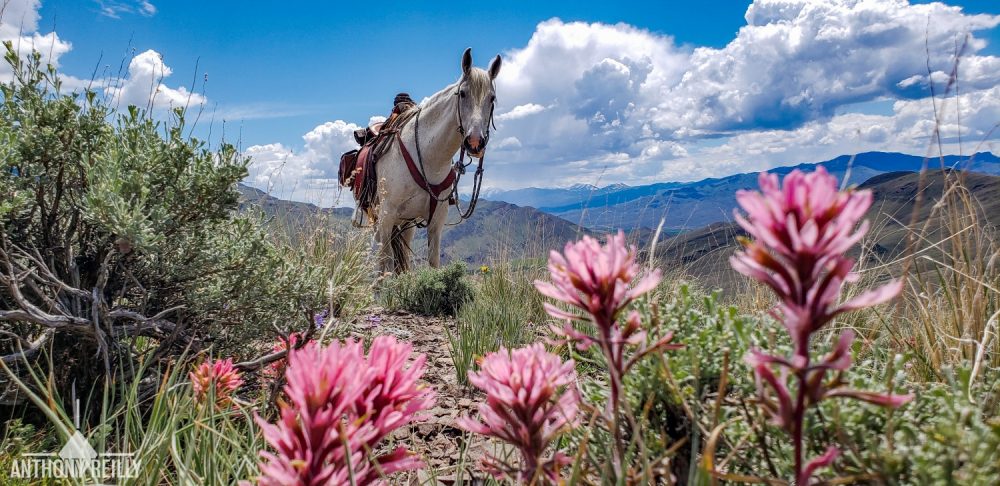
I’m certain that individuals exist who would deem this idea as impossible given the context of the world’s burgeoning population, believed by most experts to exceed 10 billion by 2050. However, I would submit to you that ancient pasturage efficiencies of nutrient dense grasses is actually significantly more efficient than that of the current paradigm of cattle production in the US: as an example, annually 25 to 45 million bison were raised by nature on the great plains of the American heartland in what later became 8 prairie states.
Today, the entire 50 States of the US produces a similar average annual output of 27 million head of cattle. Now, instead of prairie grass, most of those 8 prairie states grow two crops: corn and soybeans, predominantly for animal feeding and the subsidized production of ethanol (which in a cost accounting system easily accounts for only part of the petroleum necessary to farm said acres). The concentrate crops of the Midwest are not even close to being adequate to feed those 27 million head of cattle for their entire lives; most of the cattle fed corn only live on it for 3-6 months of their 19 month average life expectancy.
Native grasslands were evidently more productive in production of protein than our current industrial model. As an added benefit, soil carbon and biodiversity were secure.
I would submit that a majority of our “modern” agricultural advances lean heavily on fossil fuels, bioengineering, and chemical augmentation and are a net loss when soil carbon and biodiversity is included in the bottom line.
This is not a vegan or vegetarian slam. I believe those diets work for some folks and every individual is entitled to eat in a way that benefits their physical and mental wellbeing. But the categorical removal of meat from everyone’s diet is not appropriate given the prehistoric existence of grazers and the people that consumed them.
A good friend of mine, Dan Rasmussen, a rancher from an unusually unbroken grasslands area of South Dakota, once mentioned to me that “the second we start wandering from the example of nature, we get ourselves in trouble.”
And we are in trouble. But it’s not too late. Nearly all our former grasslands currently grow animal feed (most soy and corn produced feeds pigs, cows and chickens). Why not transition those acres into growing grass again and let the animals do the harvesting, as they have for millennia? It sounds simple, because it is. We cut out the middleman, the tractors, the combines, the processors, the chemical companies, and the genetic crop engineers.
And we grow grass. We let animal grazers graze. It’s what they have evolved to do so for millennia. It’s best for the soil. And the planet. And for us. On our ranch, cows, pigs and chickens graze pristine grass pastures and they thrive. Our cow weight gains on grass exceed that of many feedlots and the meat produced by these animal species tastes wonderful. Eighty-year old men and women I have served at farmer’s markets are transported back to their childhood, before the advent of the feedlot industry, by taste and smell—the strongest senses tied to memory back to when beef tasted good.
When we put animals back in touch with their grassland roots, our soil organic matter on our ranch increased from 2.5% (pretty good for agricultural land) to 7% over 10 years. This is unheard of, and it was all done with cattle, and management of the timing and intensity of their grazing. Carbon is safe here on the home ranch, and also on those 47,000 acres of semi-wild rangeland, locked from the atmosphere in soil and vegetation. Our animal carrying capacity on the land increases by twice in the same amount of time (real numbers on Alderspring). Our animals never leave the ranch and their grass pasture, bound for a feedlot and a concentrate diet. They live out their lives here, in a close relationship with the land and with us. It is a relationship between human and animal best called animal husbandry.
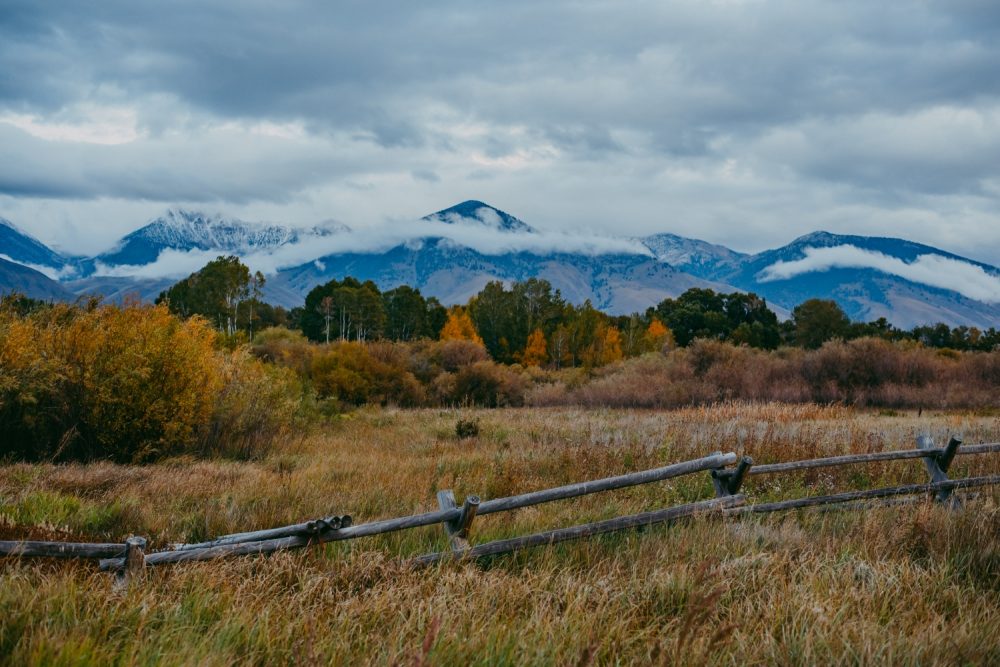
If we were to humbly return to Nature, we could begin to undo the “Unsettling” of America’s culture and agriculture, as longtime farmer and essayist Wendell Berry puts it, and we could place farmers, ranchers, and consumers back into a natural relationship with animals and soil, a relationship that has been broken by conventional agriculture. We could once again function both as pastoralists and eaters, roles wherein most of our ancestors lived and thrived for millennia.
Happy Trails.
Glenn and Caryl Elzinga, and Our Seven Daughters, and Cowhands at Alderspring Ranch
Pahsimeroi Valley
May, Idaho USA

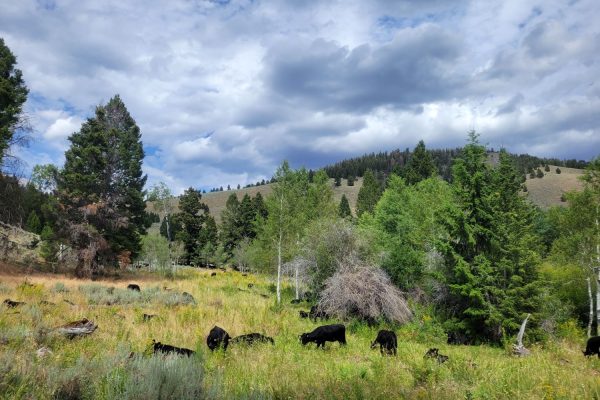
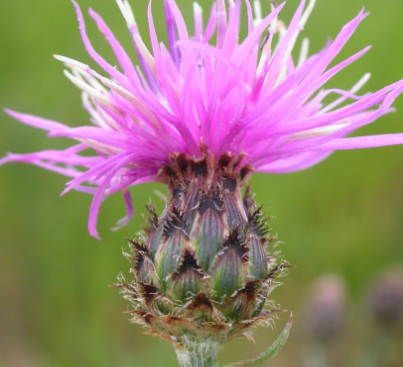
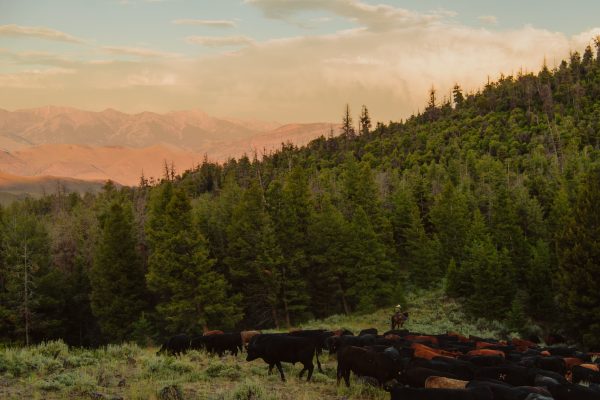
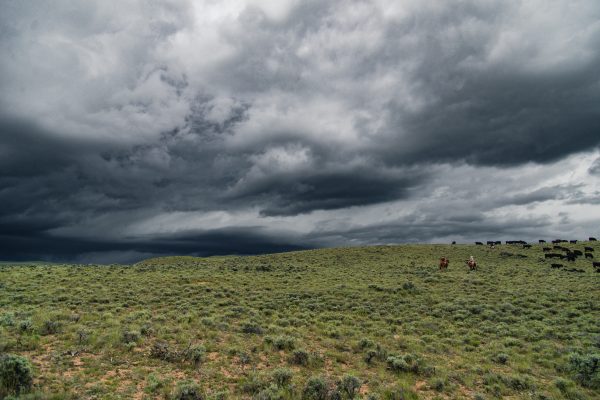


Marcia Ferrero
Well written and wonderful. Thank you for sending this to Ellen. I pray she reads it.
Glenn Elzinga
Thank-you, Marcia!
Cody Oakland
Such a well thought out and written article. We recently started ordering you Alder Springs and are so happy with your products. Our freezer is stalked with nutrition dense meats that we enjoy everyday. Cheers to you and your amazing family…
Caryl Elzinga
I’m so glad you’re enjoying our beef. Thank you for giving us a try, Cody!!
Mike Morano
Bravo. An epic effort and description. I greatly enjoyed reading it as well as eating such great beef from Alderspring!
Glenn Elzinga
Thank you, Mike! We always love seeing your comments over on insta and FB.
Susanne
Thanks, Glenn and Caryl!
I am learning so much from you!
I love the wild American West and you give me hope that it can be preserved and restored. I share your writings with friends and family here in the U.S. and Germany, including my vegans:)
Glenn Elzinga
Thank-you, Susanne! I hope the vegans don’t get too mad! I admire their convictions, but I think most of them have no idea how much wildlife must die to raise annual crops.
John Nolte
Ellen has a good heart, I think, but she is wrong about a lot of things. Pray for her. And with her 78 million followers, pray she doesn’t run for any political office! Indeed, I still enjoy my beef at all three meals of the day. That is not to say all I eat is beef, however. I love to eat chickens and pigs a lot too. Some days, I’ll eat all three: pigs for breakfast, chickens for lunch, beef for dinner: or maybe switch them around in any order really, just kinda whatever I feel like. My wife says she really likes eating rabbits, and so I am going to have to try some of those too, one of these days. She makes them sound awfully good! One thing do I know for certain is that all the best tasting and most nutritious animals come from the Glenn and Caryl Elzinga family, of the Pahsimeroi Valley, in May Idaho.
Caryl Elzinga
Those are high words of praise indeed, John! Rabbit is pretty good. With many friends that hunt for subsistence we get to try a lot of native meats. Deer, elk, antelope, bear, moose, grouse are all good. Muskrat is not.
Pat Boice
A really informative and interesting letter – I hope Ellen reads it. Just last evening I was telling a friend here in Idaho Falls about your ranch and your revival of natural ranching and protection of the environment.
Glenn Elzinga
Thank you, Pat. Appreciate you spreading the word!
Erik Storlie
Three cheers Glenn! We’ll forward this and hope others do the same.
Glenn Elzinga
Thanks, Erik!
Glenn & Pam Holloway
Glenn- I am thrilled to see you and your family doing so well and am really glad to see that your seeing improvements with inherding. It is absolutely the key to the regeneration, managing and moving. We were delighted to see a significant impact from Alan Savory’s shepherds doing the same thing in Africa and we were blessed to find the same when we managed the small 1200 acre property outside of Moscow, Idaho. Keep kickin’ over those cow pies, love seeing the hundreds of critters underneath working over the soil. Blessings to you all, you are frequently in our thoughts and prayers as you continue to steward the land. Glenn & Pam Holloway
Glenn Elzinga
Thank-you. I hope you guys are doing well. Haven’t seen much of you on social media etc.
Perry L.
I’ve learned so much of incredible value from reading your excellent articles over the past several years. I am right now in the midst of the book, The Omnivore’s Dilemma, which is providing me a further insight into the connections of healthy soil, plants, animals, our air and water, and ultimately we humans who share this planet with all of the above. You folks are doing wonderful work out there in beautiful Idaho.
Glenn Elzinga
Great book, Perry! His Food Rules is pretty good too- lighter and often funny. I’m glad you get something out of my writings, even tho I doubt I will ever achieve the heights of Pollan. Thanks for the encouragement to do what we do.
Mike Dumic
Good!
Kim
So well said!
I hope she reads it and shares with lots of friends.
Thank you for sharing why it is so important to eat truly healthy food and support the farmers who raise it. Thank you for caring and working through the many challenges to holistic farming so that earth, animals and people are all better because of what you do.
Caryl Elzinga
Thank-you, Kim! It’s hard work, but our family is passionate about it!
Maureen
Just beautiful. I’m not sure if you are familiar with the Joe Rogan podcast, but he reaches a wide audience and I think he would be very interested in interviewing you. He often features hunters and conservationists and has many nuanced discussions about mean consumption. I’d love for him to help spread your message. I wish I was famous so I could spread the word too!
Alexia Cochrane
I’m an Ellen fan — and I’m also a big, big Alderspring fan, as you guys know. I hope you hear back from Ellen. You’d be a huge hit on her show! Alexia